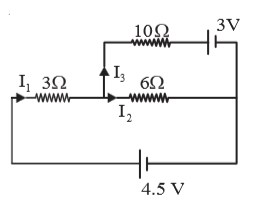In the reaction I−+I2→I−3, the Lewis acid is ……….. .
The correct Answer is:B
To determine the Lewis acid in the reaction I−+I2→I−3, we can follow these steps:
Step 1: Understand the Lewis Acid-Base Concept
A Lewis acid is defined as a substance that can accept a pair of electrons, while a Lewis base is a substance that can donate a pair of electrons.
Hint: Remember that Lewis acids are electron pair acceptors and Lewis bases are electron pair donors.
Step 2: Analyze the Reactants
In the reaction, we have:
- I− (iodide ion)
- I2 (iodine molecule)
Step 3: Identify the Electron Donor
The iodide ion I− has an extra electron, giving it a total of 8 valence electrons. This extra electron allows I− to donate a pair of electrons.
Hint: Look for the species that has an extra electron to donate.
Step 4: Identify the Electron Acceptor
The iodine molecule I2 consists of two iodine atoms bonded together. Each iodine atom has 7 valence electrons, and when they bond, they share a pair of electrons. However, I2 can accept an additional pair of electrons from I− to form the I−3 ion.
Hint: Consider which species can accept electrons to form a new bond.
Step 5: Formation of the Dative Bond
When I− donates a pair of electrons to I2, it forms a dative bond, resulting in the formation of I−3. In this process, I2 acts as the electron acceptor.
Hint: The formation of a new bond indicates which species is acting as the acid.
Conclusion
Based on the analysis, the Lewis acid in the reaction I−+I2→I−3 is I2, as it accepts the pair of electrons from the iodide ion.
Final Answer: The Lewis acid is I2.
A Lewis acid is defined as a substance that can accept a pair of electrons, while a Lewis base is a substance that can donate a pair of electrons.
In the reaction, we have:
- I− (iodide ion)
- I2 (iodine molecule)
The iodide ion I− has an extra electron, giving it a total of 8 valence electrons. This extra electron allows I− to donate a pair of electrons.
The iodine molecule I2 consists of two iodine atoms bonded together. Each iodine atom has 7 valence electrons, and when they bond, they share a pair of electrons. However, I2 can accept an additional pair of electrons from I− to form the I−3 ion.
When I− donates a pair of electrons to I2, it forms a dative bond, resulting in the formation of I−3. In this process, I2 acts as the electron acceptor.
Based on the analysis, the Lewis acid in the reaction I−+I2→I−3 is I2, as it accepts the pair of electrons from the iodide ion.
Topper's Solved these Questions
- IONIC EQUILIBRIUMBOOK - CENGAGE CHEMISTRY ENGLISHCHAPTER - IONIC EQUILIBRIUMEXERCISE - Archives True/False
3 Videos
- IONIC EQUILIBRIUMBOOK - CENGAGE CHEMISTRY ENGLISHCHAPTER - IONIC EQUILIBRIUMEXERCISE - Archives Subjective
28 Videos
- IONIC EQUILIBRIUMBOOK - CENGAGE CHEMISTRY ENGLISHCHAPTER - IONIC EQUILIBRIUMEXERCISE - Archives Integer
4 Videos
- HYDROGEN, WATER AND HYDROGEN PEROXIDEBOOK - CENGAGE CHEMISTRY ENGLISHCHAPTER - HYDROGEN, WATER AND HYDROGEN PEROXIDEEXERCISE - Subjective Archive (Subjective)
3 Videos
- ISOMERISMBOOK - CENGAGE CHEMISTRY ENGLISHCHAPTER - ISOMERISMEXERCISE - Assertion-Reasoning Type
1 Videos
Similar Questions
Knowledge Check
Calculate the euilibrium constant for the reaction,
2Fe3++3I−⇔2Fe2++I−3.
The standard reduction potential in acidic conditions are 0.77V and 0.54V respectivelu for Fe3+/Fe2+ and I−3/I− couples.A4.25×107B7.05×105C6.25×105D6.25×107In the reaction,
I2+2S2O2−3→2I−+S4O2−6.
AI2 is reducing agent.BI2 is oxidising agent and S2O2−3 is reducing agentCS2O2−3 is oxidising agent.DI2 is reducing agent and S2O2−3 is oxidising agent.
For the reaction , Cl2+2I−→I2+2Cl−, the initial concentration of I− was 0.20mol lit−1 and the concentration after 20 minutes was 0.18mol lit−1. Then the rate of formation of I2 in mol lit−1−1min would be
View SolutionFind the current I1, I2, & I3, in the circuit.

View SolutionI2+KI→KI3
In the above reaction :-
View SolutionFind the standard electrode potential of I2∣2Ic− if the equilibrium constant for the reaction I2+Ic−→′(I3)c− is 703. The standard electrode potential of Ic−3∣3Ic− is 0.5355V. Also give the electrode reaction.
View SolutionFor the reaction, 2HI(g)→H2(g)+I2(g)−QKJ , the equilibrium constant depends upon
View SolutionRate constant for a reaction H2+I2→2HI is 49, then rate constant for reaction 2HI→H2+I2 is
View Solution
